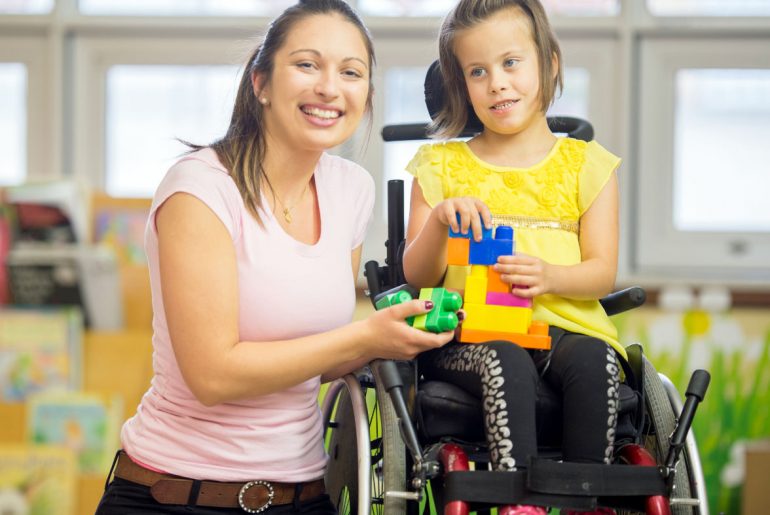Children and their parents find cerebral palsy a difficult condition to cope with. The neurological condition cerebral palsy can affect the way that your child’s mind controls their movements. The brain development of a child is the cause of this disorder. It can be diagnosed at birth or very early in life. Most children with cerebral palsy can still transition to adulthood and be productive members of their community.
You may feel helpless as a parent when you see your child struggling with this disease. With the right treatment and care, you can make your child’s life easier. Here are a few things to keep in mind when caring for a child who has cerebral palsy.

What Does Cerebral Palsy look like?
Your child’s motor problems will depend on their cerebral palsy and the damage to the brain. Spastic cerebral palsy is the most common type, and it involves stiff or difficult movement. Ataxic cerebral Palsy affects balance, depth perception and motor coordination. Athetoid cerebral palsy causes uncontrollable or involuntary movements. Children can also have a mixed form of cerebral palsy that encompasses many symptoms.
The symptoms of cerebral paralysis usually appear within the first 2 or 3 years of life. Children with mild cerebral palsy can still walk and run but they do it a little later than other children. Some children may also need mobility aids such as leg braces or wheelchairs.
What are the problems associated with cerebral palsy?
Your child may experience other impairments, such as vision, hearing and speech problems, or motor skills. Cerebral palsy, although associated with learning difficulties, is not the same as intelligence. Even if your child has cerebral palsy they can still be intelligent.
This condition is often associated with epilepsy and other seizure disorders. You may also want to explore your options for Gamot sa Epilepsy in order to manage symptoms such as convulsions and joint stiffness.
What are the treatment options?
Treatments will vary according to your child’s symptoms. Your child may need the help of a multidisciplinary group of therapists and physicians, as well as psychologists, social workers and educators. These professionals can help your child with issues related to mobility, nutrition, communication, education, or socio-emotional growth.
Physical therapy or physiotherapy is another common treatment for cerebral paralysis. A physical therapist will help your child strengthen their muscles and avoid bone problems. They can also maintain their physical abilities, which could improve their condition. A speech therapist may also be needed to help your child, particularly if they are having problems with facial muscle control and oral motor function. An occupational therapist can help your child achieve functional independence.
How do I manage my mealtimes?
It can be difficult for children with cerebral palsy to finish meals and obtain the nutrition they require. Your child may require a speech therapist who will help strengthen the muscles in their mouth to make eating easier. If this doesn’t work, you may have to fit your child with a G-tube (Gastrostomy Feeding Tube).
Children with cerebral palsy usually require a special diet. It may be helpful to work with a pediatrician or nutritionist to create a diet plan. Vegetables and fruits are a good part of a healthy diet for children with cerebral palsy. You can also include foods rich in calcium, vitamin D, and phosphorus to help strengthen your child’s bone structure. Fill your child’s food intake with dairy products, orange juices, cereals, poultry, eggs, nuts, whole grains and fish.
How do I manage their daily hygiene?
If you have a cerebral palsy child, it is important to accept that they will need additional assistance in everyday activities like bathing, brushing teeth and dressing. Working with a physical therapy can help you guide your child in these daily activities. You can also learn how to do home therapy. You can help them dress themselves by having them lie on their side or hold onto something sturdy.
You can also get your child something solid to hold onto when bathing or using the toilet. You can help your child bathe and go to the toilet by getting non-slip mats, grab bars or a semireclined seat with suction cup. You can make hygiene education fun for your child by combining bath and potty training with games.
How do I handle playtime and bedtime?
Due to their limited mobility, your child’s playtime might look different. It’s important to work closely with your physical therapist in order to determine the best exercises and games for your child. Some of these activities include dancing, ball games, yoga and swimming.
It is important to keep active during the day in order to reduce restlessness at nights. Children with cerebral palsy may have difficulty sleeping due to their pain and issues with movement. You may wish to consult your doctor about the best sleeping positions for your child.
How can I ensure a normal life for my child?
It takes a lot of patience and open-mindedness to be a parent with a cerebral palsy child. You are not being unreasonable if you wish your child a normal, happy life. It is also your responsibility as a parent that your child be accepted and supported.
Even if your child has a lifelong condition, raising them is a difficult task. It’s still important to teach your child that they’re not powerless. They can handle their condition well, grow, and ask for assistance when necessary. It takes love from a parent to encourage a child to overcome their limits and be the best that they can.